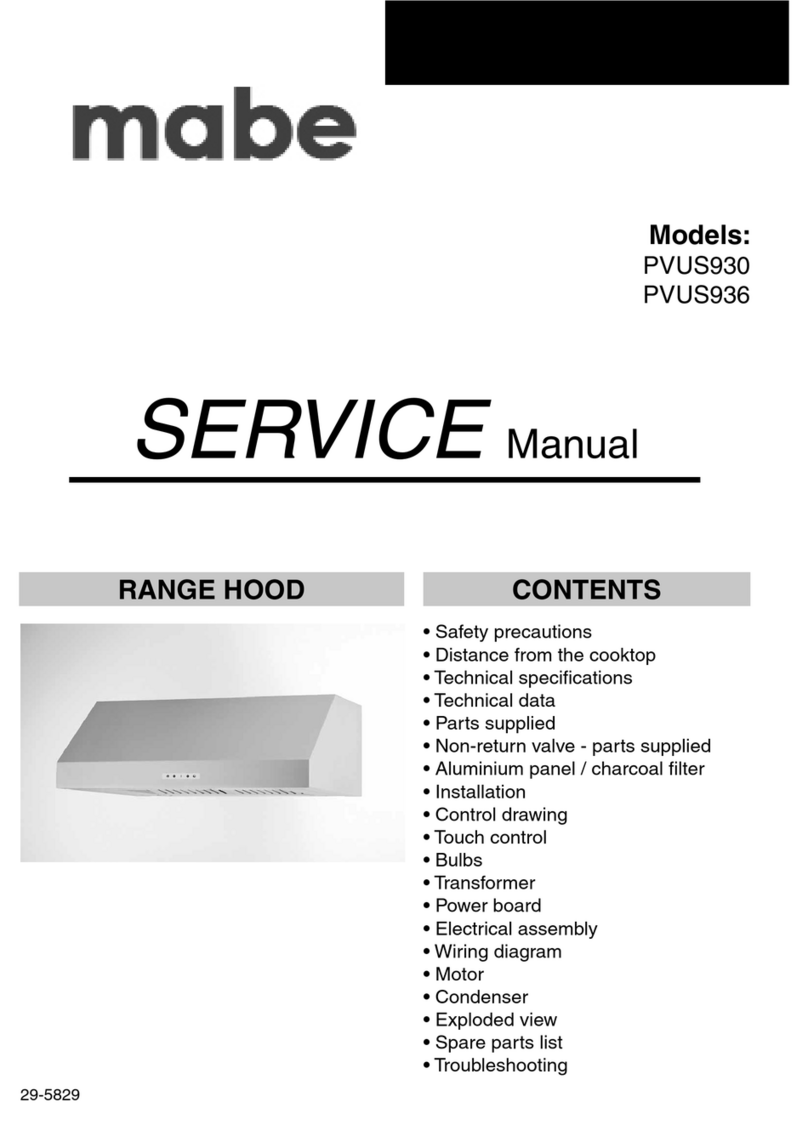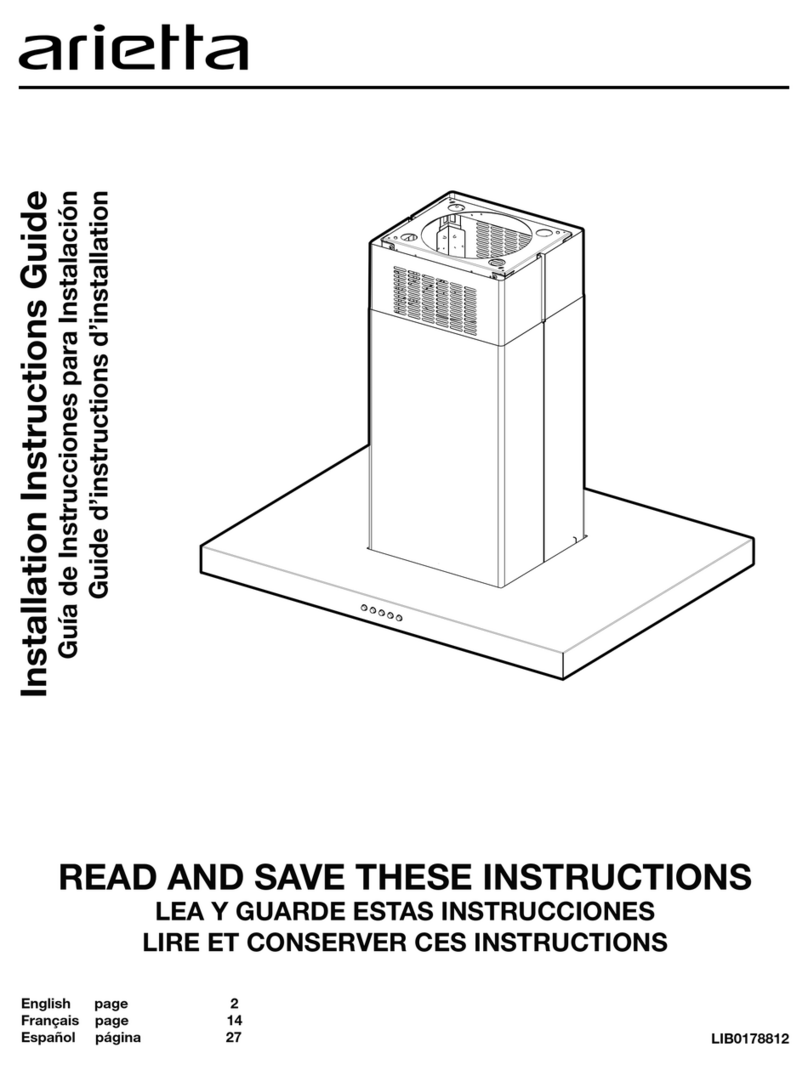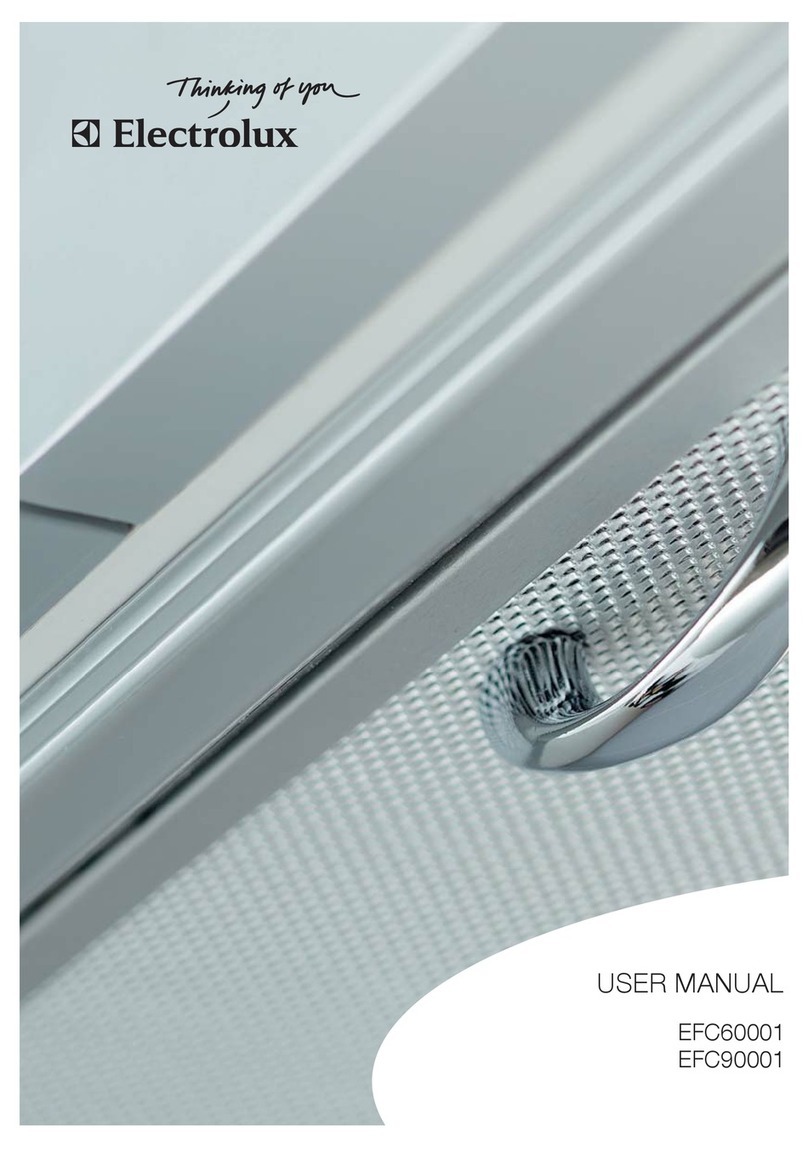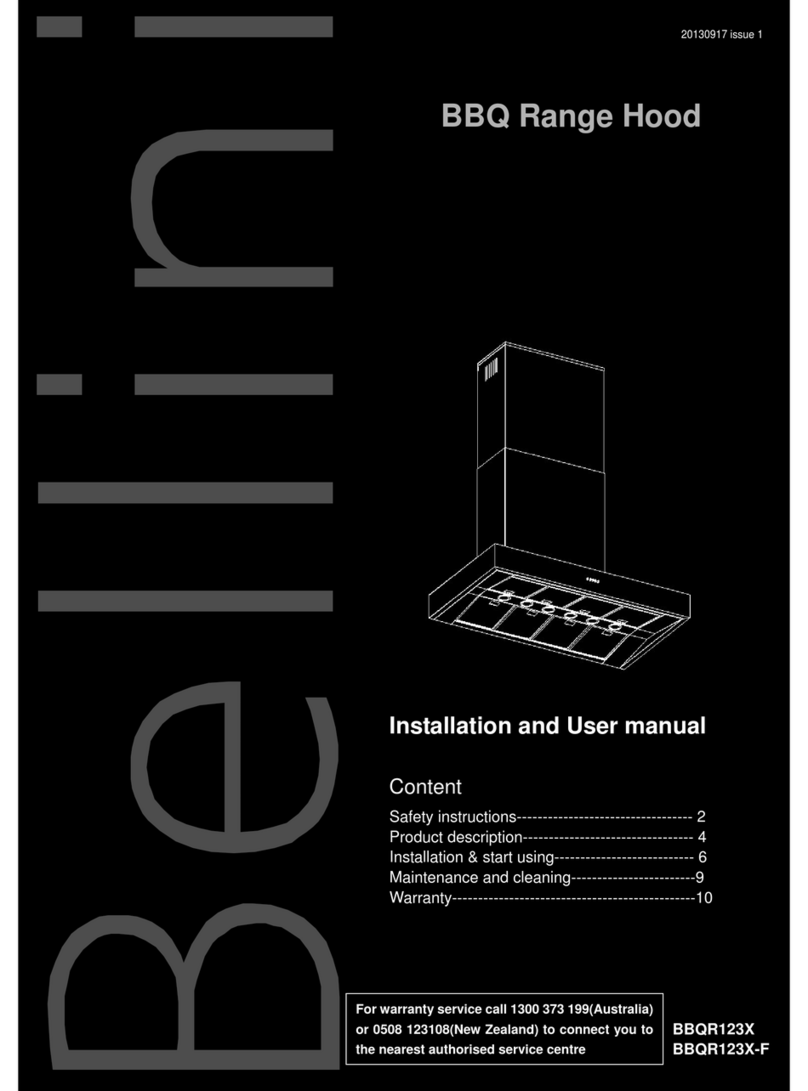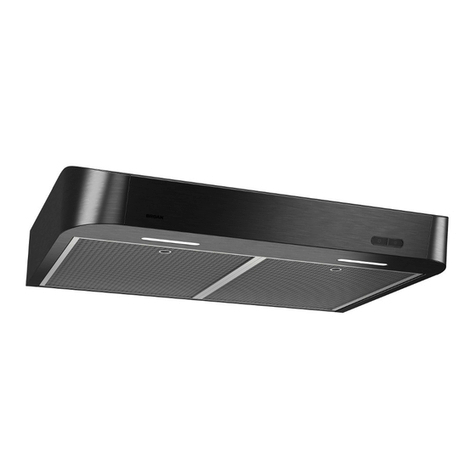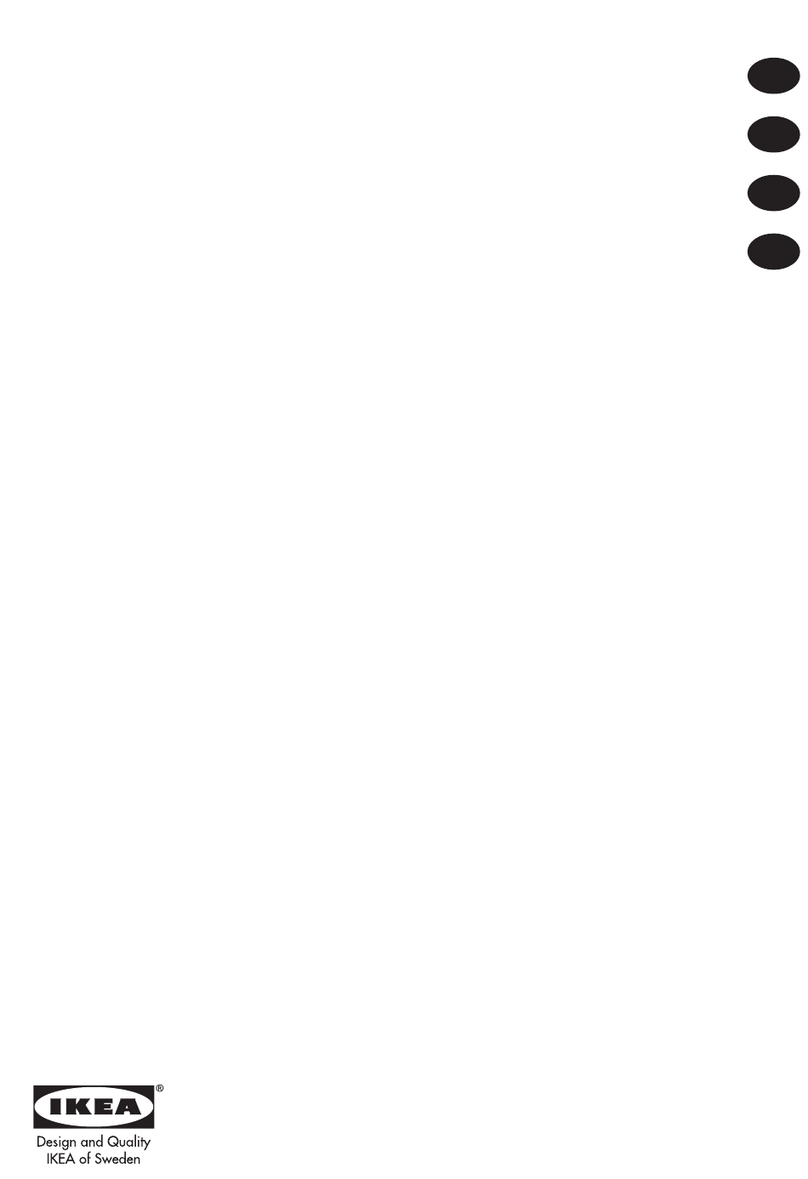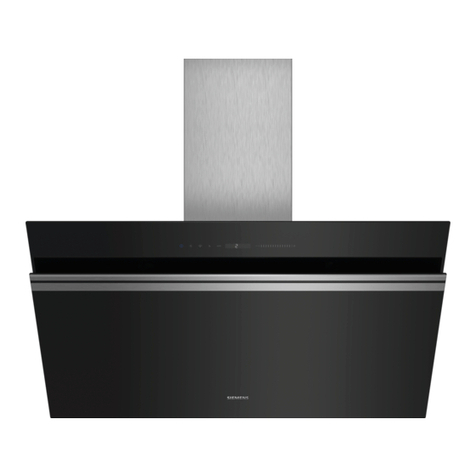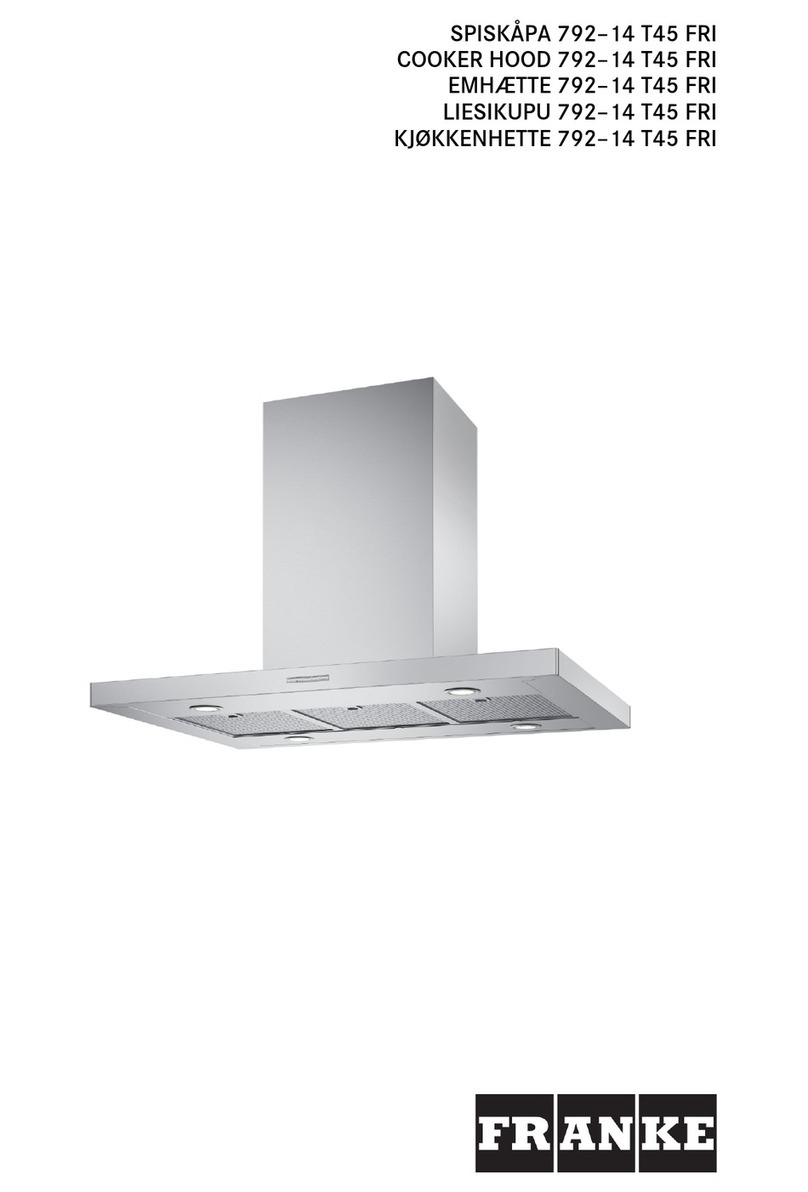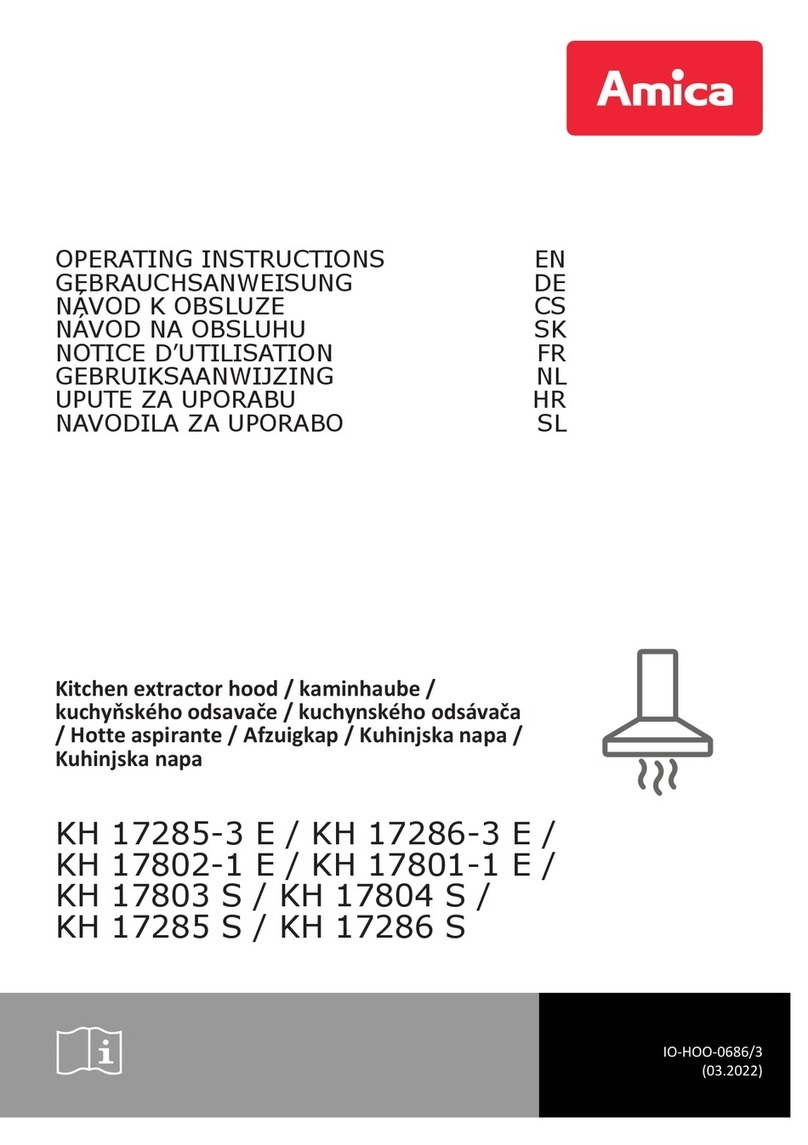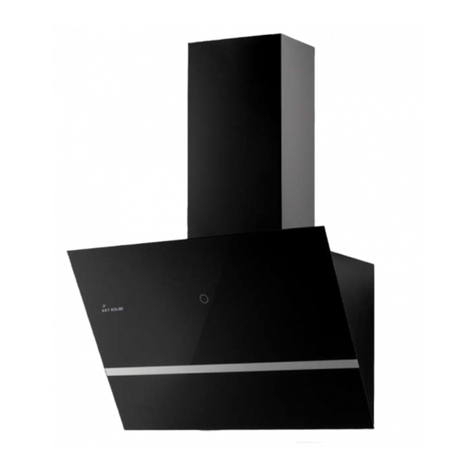mabe CM6031XWW Original instructions

1
owner's manual &
installation instructions
range hoods
model
CM6031XWW
read this manual before installing your new range hood
PM01

2

3
Write the model and serial numbers here:
Model #
Serial #
You can find them on a label on the back wall of the hood.
Safety Information ............................................................................. 4
Operating/Care and Cleaning Instructions
Controls .................................................................................................. 6
Grease Filter ........................................................................................... 6
Charcoal Filter ........................................................................................ 7
Hood Surfaces ........................................................................................ 7
Hood Light ............................................................................................. 8
Installation Instructions .................................................................... 9
contents

4
IMPORTANT SAFETY INFORMATION.
READ ALL INSTRUCTIONS BEFORE
USING.
SAFETY PRECAUTIONS
A. Use this unit only in the manner intended by the manufacturer. If
you have questions, contact the manufacturer.
B. Before servicing or cleaning unit, switch power off at service
panel and lock the service disconnecting means to prevent power
from being switched on accidentally. When the service disconnect-
ing means cannot be locked, securely fasten a prominent warning
device, such as a tag, to the service panel.
C. Do not use this unit with any solid-state speed control device.
D. This unit must be grounded.
E. If the supply cord is damaged, it must be replaced by the manu-
facturer, its service agent or similarly qualified persons in order to
avoid a hazard.
F. Do not flame under the range hood.
G. There is a fire risk if cleaning is not carried out in accordance with
the instructions.
H. This unit is not to be used by children or persons with reduced
physical, sensory or mental capabilities, or lack of experience and
knowledge, unless they have been given supervision or instruc-
tion.
WARNING – TO REDUCE THE RISK OF FIRE, ELECTRIC SHOCK
OR INJURY TO PERSONS, OBSERVE THE FOLLOWING:
CAUTION – FOR GENERAL VENTILATING USE ONLY. DO NOT
USE TO EXHAUST HAZARDOUS OR EXPLOSIVE MATERIALS AND
VAPORS.
CAUTION – ACCESSIBLE PARTS MAY BECOME HOT WHEN
USED WITH COOKING APPLIANCES.
WARNING – TO REDUCE THE RISK OF INJURY TO PERSONS
IN THE EVENT OF A RANGE TOP GREASE FIRE, OBSERVE THE FOL-
LOWING*:
A. SMOTHER FLAMES with a close-fitting lid, cookie sheet or metal
tray, then turn off the burner BE CAREFUL TO PREVENT BURNS.
If the flames do not go out immediately, EVACUATE AND CALL
THE FIRE DEPARTMENT.
B. NEVER PICK UP A FLAMING PAN—You may be burned.
C. DO NOT USE WATER, including wet dishcloths or towels—a vio-
lent steam explosion will result.

5
D. Use an extinguisher ONLY if:
1. You know you have a Class ABC extinguisher, and you already
know how to operate it.
2. The fire is small and contained in the area where it started.
3. The fire department is being called.
4. You can fight the fire with your back to an exit.
*Based on "Kitchen Fire Safety Tips" published by NFPA.
WARNING – TO REDUCE THE RISK OF A RANGE TOP GREASE
FIRE:
A. Never leave surface units unattended at high settings. Boilovers
cause smoking and greasy spillovers that may ignite. Heat oils
slowly on low or medium settings.
B. Always turn hood ON when cooking on high heat or when
flambéing food (i.e. Crepes Suzette, Cherries Jubilee, Peppercorn
Beef Flambé).
C. Clean ventilating fans frequently. Grease should not be allowed
to accumulate on fan or filter.
D. Use proper pan size. Always use cookware appropriate for the
size of the surface element.
WARNING – TO REDUCE THE RISK OF FIRE, ELECTRIC SHOCK
OR INJURY TO PERSONS, OBSERVE THE FOLLOWING:
A. Installation work and electrical wiring must be done by qualified
person(s) in accordance with all applicable codes and standards,
including fire-rated construction.
B. Sufficient air is needed for proper combustion and exhausting of
gases through the flue (chimney) of fuel burning equipment to
prevent back drafting. Follow the heating equipment
manufacturer’s guideline and safety standards such as those pub-
lished by the National Fire Protection Association (NFPA), the
American Society for Heating, Refrigeration and Air Conditioning
Engineers (ASHRAE) and the local code authorities. When appli-
cable, install any makeup (replacement) air system in accordance
with local building code requirements.
C. When cutting or drilling into wall or ceiling, do not damage elec-
trical wiring and other hidden utilities.
D. Ducted fans must always be vented to the outdoors.
E. There should be adequate ventilation of the room when the
range hood is used at the same time as appliances burning gas or
other fuels.
WARNING – TO REDUCE THE RISK OF FIRE AND TO PROP-
ERLY EXHAUST AIR, BE SURE TO DUCT AIR OUTSIDE—DO NOT
VENT EXHAUST AIR INTO SPACES WITHIN WALLS OR CEILINGS
OR INTO ATTICS, CRAWL SPACES OR GARAGES. DO NOT VENT
EXHAUST AIR INTO A FLUE THAT IS USED FOR EXHAUSTING
FUMES FROM APPLIANCES BURNING GAS OR OTHER FUELS.

6
1 2
WARNING – TO REDUCE THE RISK OF FIRE, USE ONLY METAL
DUCTWORK.
• Do not attempt to repair or replace any part of your hood un-
less it is specifically recommended in this guide. All other servic-
ing should be referred to a qualified technician.
READ AND FOLLOW THIS SAFETY
INFORMATION CAREFULLY.
READ AND SAVE THESE INSTRUCTIONS.
using the hood controls
control knobs
1. FAN Control Turn to HI, MED or LO as needed.
Continuous use of the fan system while cooking helps keep the
kitchen comfortable and less humid. It also reduces cooking odors
and soiling moisture that create a frequent need for cleaning.
2. LIGHT Control
Turn to ON while cooking or to NITE for use as a night light.
reusable metal grease filter—ducted installations
only
The efficiency of your hood depends on a clean filter. Frequency of
cleaning depends on hood use and the type of cooking you do.
However, the grease filter should be cleaned at least once a
month.
To remove: Pull down on the center of the front edge of the filter.
The filter will then slip out of the retaining tabs on the back.
To replace: Slip the back edge of the filter into the retaining tabs
and push the front edge up until it snaps into place.

7
Replaceable charcoal filter
Grease filter
To clean: Soak and then agitate it in a hot water and detergent so-
lution. Light brushing can be used to remove embedded dirt. Rinse,
shake and let it dry before replacing.
NEVER OPERATE THE HOOD WITHOUT THE FILTER IN PLACE.
With careful handling, the metal filter will last for years. If a new re-
placement filter becomes necessary, order the part from your dealer.
charcoal filter—recirculating installations only
The charcoal filter cannot be cleaned. It must be replaced. Order fil-
ter no. WB02X10700.
If the hood is not vented to the outside, the air will be recirculated
through a disposable charcoal filter that helps remove smoke and
odors.
The charcoal filter should be replaced after 6 to 12 months (depend-
ing on hood usage).
To remove: Pull down on the center of the front edge of the filter.
The filter will then slip out of the retaining tabs on the back.
To replace: Slip the back edge of the filter into the retaining tabs
and push the front edge up until it snaps into place.
NOTE: DO NOT rinse, or put
charcoal filters in an automatic
dishwasher.
painted surfaces
Do not use steel-wool pads or other abrasive cleaners. They will
scratch the surface.
Clean grease-laden surfaces of the hood frequently. To clean the
hood surface, use a hot, damp cloth with a mild detergent suitable
for painted surfaces. About one tablespoon of ammonia may be
added to the water. Use a clean, hot, damp cloth to remove soap.
Dry with a dry, clean cloth.
NOTE: When cleaning, take care not to come in contact with filters
and other nonenameled surfaces.

8
CAUTION: When cleaning the hood surfaces, be certain that
you do not touch the light bulb with moist hands or cloth. A
warm or hot light bulb may break if touched with a moist sur-
face. Always let the light bulb cool completely before cleaning
around it.
hood light
CAUTION: Let the light bulb cool completely before remov-
ing. A warm or hot bulb may break if touched with a moist cloth
Remove the bulb and replace it with an incandescent light bulb with
an ordinary screw base, not more than 60 Watts, or a Compact
Fluorescent (CFL) light bulb with an ordinary screw base, not more
than 13 Watts.
IMPORTANT: For installation, handling and disposal precautions, re-
fer to the fluorescent bulb packaging literature.
To replace the light cover:
• Insert the prong located at the end of the cover into the top open-
ing.
• Gently push the cover up and press the sides to fit the side prongs
into the side openings.
• Release and the cover will lock in position.
To remove the light cover
• Press the sides with two fingers until the side prongs are released.
• Lift the light cover and slide it toward you in one motion.
Light cover

9
installation instructions
range hood
BEFORE YOU BEGIN
Read these instructions completely and carefully.
• IMPORTANT – Save these instructions for local inspector’s
use.
• IMPORTANT – Observe all governing codes and ordinances.
• Note to Installer - Be sure to leave these instructions with the
Consumer.
• Note to Consumer – Keep these instructions for future reference.
• Skill level – Installation of this appliance requires basic mechanical
and electrical skills.
• Completion time – 30 minutes–3 hours.
• Proper installation is the responsibility of the installer.
• Product failure due to improper installation is not covered under
the Warranty.
FOR YOUR SAFETY:
WARNING – Before beginning the installation, switch power
off at service panel and lock the service disconnecting means to
prevent power from being switched on accidentally. When the
service disconnecting means cannot be locked, securely fasten a
prominent warning device, such as a tag, to the service panel.
DUCTWORK REQUIREMENTS
NOTE: Read the ductwork sections only if you do not have existing
ductwork. If you have existing ductwork, skip to the “Damage” sec-
tion and proceed.
WARNING – TO REDUCE THE RISK OF FIRE AND TO PROP-
ERLY EXHAUST AIR, BE SURE TO DUCT AIR OUTSIDE—DO
NOT VENT EXHAUST AIR INTO SPACES WITHIN WALLS OR
CEILINGS OR INTO ATTICS, CRAWL SPACES OR GARAGES.
The venting system must exhaust to the outside.
This hood can be vented vertically through upper cabinets or hori-
zontally through an outside wall. Ductwork is not included.
Exhaust connection:
The hood exhaust has been designed to mate with standard 3 1/4" x
10" rectangular ducting or 7" diameter round ducting.
If a 6" round duct is required, a rectangular-to-round transition
adaptor must be used*. Do not use less than a 6" diameter duct.

10
Maximum duct length:
For satisfactory air movement, the total duct length of a 3 1/4" x 10"
rectangular, 6" or 7" diameter round duct should not exceed 65
equivalent feet. See the WORKSHEET–CALCULATE TOTAL
EQUIVALENT DUCTWORK LENGTH section.
NOTE: It is important that ducting be installed using the most direct
route and with as few elbows as possible. This ensures clear venting
of exhaust and helps prevent blockages. Also, make sure dampers
swing freely and nothing is blocking the ducts. When applicable, in-
stall any makeup (replacement) air system in accordance with local
building code requirements.
Elbows, transitions, wall and roofcaps, etc., present additional
resistance to airflow and are equivalent to a section of straight duct
longer than their actual physical size. When calculating the total
duct length, add the equivalent lengths of all transitions and adap-
tors plus the length of all straight duct sections. The charts on the
following pages show you how to calculate total equivalent
ductwork length using the approximate feet of equivalent length of
some typical ducts.
* IMPORTANT: If a rectangular-to-round transition
adaptor is used, the bottom corners of the damper
will have to be cut to fit using tin snips, in order to
allow free movement of the damper. Equivalent
lengths of duct pieces are based on actual tests and
reflect requirements for good venting performance
with any hood.

11
Duct Pieces
3 1/4" x 10"
Rect., straight
Equivalent
Length
Number
used
XTotal
=
Ft.
7" Round,
straight
6" Round,
straight
3 1/4" x 10"
Rect. 90°
elbow
3 1/4" x 10"
Rect. 45°
elbow
3 1/4" x 10"
Rect. 90° flat
elbow
3 1/4" x 10"
Rect. wall cap
with damper
3 1/4" x 10"
Rect. to
6" round
transition
3 1/4" x 10"
Rect. to
6" round
transition 90°
elbow
6" Round,
90° elbow
6" Round,
45° elbow
Subtotal column 1 =
Ft.
Ft.
Ft.
Ft.
Ft.
Ft.
Ft.
Ft.
Ft.
Ft.
Ft.
24 Ft.
(18 ft.
w/o
damper)
x ( ) =
x ( ) =
1 Ft. x ( ) =
1 Ft. x ( ) =
2 Ft. x ( ) =
1 Ft. x ( ) =
14 Ft. x ( ) =
8 Ft. x ( ) =
33 Ft. x ( ) =
4 Ft. x ( ) =
25 Ft. x ( ) =
16 Ft. x ( ) =
Column 1
WORKSHEET—CALCULATE TOTAL EQUIVALENT
DUCTWORK LENGTH

12
Duct Pieces
6" Round wall
cap with
damper
6" Round
roof cap
6" Round to
3 1/4" x 10"
rect. transition
6" Round to
3 1/4" x 10"
rect. transition
90° elbow
7" Round,
90° elbow
7" Round,
45° elbow
7" Round,
wall cap with
damper
7" Round,
roof cap
7" Round to
3 1/4" x 10"
rect. transition
7" Round to
3 1/4" x 10"
rect. transition
90° elbow
Subtotal column 2 =
Subtotal column 1 =
Total ductwork =
Total
Equivalent
Length
Number
used
X=
1 Ft. x ( ) =
1 Ft. x ( ) =
1 Ft. x ( ) =
1 Ft. x ( ) =
1 Ft. x ( ) =
1 Ft. x ( ) =
1 Ft. x ( ) =
1 Ft. x ( ) =
1 Ft. x ( ) =
1 Ft. x ( ) =
Ft.
Ft.
Ft.
Ft.
Ft.
Ft.
Ft.
Ft.
Ft.
Ft.
Ft.
Ft.
Ft.
Ft.
Column 2
MAXIMUM DUCT LENGTH: For satisfactory air movement, the total
duct length of a 3 1/4" x 10" rectangular, 7" diameter round duct
should not exceed 65 equivalent feet.

13
66 or more
from the
floor to the
top of the
hood
24, 30 or 36 to match
cooktop idth 30
min.
Bottom edge of
cabinet needsçto
be 30 or more
from the
cooking surface
NOTE: Any home ventilation system, such as a ventilation hood, may
interrupt the proper flow of combustion air and exhaust required by
fireplaces, gas furnaces, gas water heaters and other naturally
vented systems. To minimize the chance of interruption of such
naturally vented systems, follow the heating equipment
manufacturer’s guidelines and safety standards such as those pub-
lished by NFPA and ASHRAE. When applicable, install any makeup
(replacement) air system in accordance with local building code re-
quirements.
DAMAGE - SHIPMENT/INSTALLATION
• If the unit is damaged in shipment, return the unit to the store in
which it was bought for repair or replacement.
• If the unit is damaged by the customer, repair or replacement is
the responsibility of the customer.
• If the unit is damaged by the installer (if other than the customer),
repair or replacement must be made by arrangement between cus-
tomer and installer.
MOUNTING SPACE
NOTES:
• Hood width may be greater than the width of the range or cook-
top, but it may not be smaller.
• Ensure the range or cooktop is installed per manufacturer’s instal-
lation instructions.
• If you are going to vent your range hood to the outside, see the
"Ducting Requirements" section for exhaust duct preparation.

14
Flat-blade and Phillips
scre drivers
Pencil
Duct tape
Sa (saber or
keyhole)
Electric drill
Metal snips
(in some
applications)
1/4
pivoting
hex socket
Pliers Tape measure Wire stripper
Flashlight Caulking Level 1/4 Nutdriver
Grease Filter
Charcoal Filter
Part
Mounting screws (8 - 18 x 3/4"
Phillips pan head)
Exhaust Adaptor (for 3 1/4" x 10"
rect. venting)
Exhaust Adaptor Screw (8 - 18 x 3/8"
Phillips pan head or hex head)
TOOLS YOU WILL NEED
Quantity
4
1
1
PARTS INCLUDED
1
1

15
1 CHOOSE VENT OPTION
A
Determine the vent option that your installation will require and
that is available for your model from the below choices.
IMPORTANT: If the hood is to be installed in a recirculating,
non-vented, ductless manner, do not knock out any vent
openings in the hood.
B
C
D
Outside top exhaust (Vertical duct 3-1/4" x 10" Rectangular)
Recirculating (non-vented/ductless)
Outside rear exhaust (Horizontal duct 3-1/4" x 10" Rectangu-
lar)
Outside top exhaust (Vertical duct 7" Round)

16
2 REMOVE EXHAUST ADAPTOR
If exhausting/venting using the 3 1/4" x 10" rectangular duct.
Remove the exhaust adaptor from the inside of the hood. Set it
aside along with its mounting screws.
3¼ x 10
rectangular
exhaust
adaptor
and scre s
3
4
REMOVE FILTER
Remove the shipping tape holding the metal grease filter in
place. Pull down on the center of the front edge of the filter.
The filter will then slip out of the retaining tabs on the back.
Metal grease filter
REVERSE THE BAFFLE, FOR DUCTED INSTALLA-
TIONS ONLY
If the hood is to be recirculated, skip to the next step. Remove
the baffle from the top of the hood. Reinstall the baffle so the
short side marked "VENTED" is visible. The long side of the
baffle should be inside the hood.
VENTED is visible

17
3¼ x 10 Rectangular
vertical discharge.
Remove top rectangular
duct knockout only.
7 Round vertical discharge.
Remove circular duct
knockout only
3¼ x 10 Rectangular horizontal discharge.
Remove rear rectangular duct knockout only
5
6
REMOVE DUCT KNOCKOUT
If recirculating, non-vented ductless skip to Step 9 D and
proceed.
Using a flat-blade screwdriver, remove the appropriate duct
knockout from the top or back of the hood.
FOR 3-1-4" X 10" RECTANGULAR DUCTED DIS-
CHARGE INSTALLATIONS ONLY:
Attach exhaust adaptor/damper over the appropriate knock-
out opening (for vertical or horizontal, depending on installa-
tion) with two exhaust adaptor screws. Make sure damper
pivot is nearest to top/back edge of hood. Remove tape from
damper flap.
Tape
Exhaust adaptor/damper
(vertical discharge position)
Exhaust adaptor/damper
(horizontal discharge position)
Top/back edge
Pivot
(depending on
installation)

18
7
8
FOR 7" ROUND VERTICAL DUCTED DISCHARGE
INSTALLATIONS ONLY:
Bend up the duct alignment ears in preparation for later at-
tachment of the 7" duct.
Attachment ear tabs
FOR RECESSED-BOTTOM CABINETS ONLY
If the cabinets have front, side or back trim, make 2 wood
shims a minimum of 3/8" thick and cut to fit the width of the
inner recessed cabinet bottom. Attach them to the cabinet bot-
tom recess on both sides. See Step 9 for marking locations.
Wood shims
(minimum thickness 3/8)

19
9 MARK HOLES
Select the vent option that your installation will require and
proceed to that section:
A. Outside top exhaust
(Vertical duct 3-1/4" x 10" Rectangular)
Use the diagram or the hood as a template and mark the loca-
tions on the cabinet for ductwork and keyhole screw slots.
10¾ (24 hood)
13¾ (30 hood)
16¾ (36 hood)
Cabinet front
Wood shims (recessed-
bottom cabinets only-shims
must be a minimum of 3/8
thick and cut to fit the idth
of the inner recessed cabinet
bottom).
Center
line
3¼
1/2
5¼
Vertical duct
access hole
Cabinet bottom
Hood mounting scre s (4)
10¾ (24 hood)
13¾ (30 hood)
16¾ (36 hood)
5¼
1
9
5/8
3/8
B. Outside top exhaust (Vertical duct 7" Round)
Use the diagram or the hood as a template and mark the loca-
tions on the cabinet for ductwork and keyhole screw slots.
1
5¾
9
10¾ (24 hood)
13¾ (30 hood)
16¾ (36 hood)
Cabinet front
Wood shims (recessed-
bottom cabinets only-shims
must be a minimum of 3/8
thick and cut to fit the idth
of the inner recessed cabinet
bottom).
Center
line
Cabinet bottom
Hood mounting scre s (4)
10¾ (24 hood)
13¾ (30 hood)
16¾ (36 hood)
Access
hole for 7
round duct
8 DIA
HOLE
5/8
3/8

20
Center line
5¼
9,5 cm
Horizontal duct
access hole
Cabinet front
1/2
Wood shims
(recessed-bottom cabinets only-shims must be
a minimum of 3/8 thick and cut to fit the idth
of the inner recessed cabinet bottom).
Parte inferior
del gabinete 5¼
10¾ (24 hood)
13¾ (30 hood)
16¾ (36 hood)
Hood mounting scre s (4)
10¾ (24 hood)
13¾ (30 hood)
16¾ (36 hood)
C. Outside rear exhaust
(Horizontal duct 3 1/4" x 10" Rectangular)
Use the diagram or the hood as a template and mark the loca-
tions on the cabinet for ductwork and keyhole screw slots.
D. Recirculating
• Use the hood as a template and mark the locations on the
cabinet for ductwork and keyhole screw slots.
• Since the hood is to be recirculated (not to be vented out-
side), do not cut out any vent openings in the wall or cabinet
bottom.
CUT HOLES
Cut holes at marked locations for duct. For the vertical duct,
cut out 3/4" extra toward the front of the cabinet so you can
move the duct freely when installing the hood. It may also ease
installation by cutting the hole 10 1/2" instead of 10".
SCREW IN PART WAY
Drive a mounting screw (from the hardware packet) part way
into each center of the narrow neck of the keyhole slots
marked on the cabinet bottom.
10
11
Table of contents
Other mabe Ventilation Hood manuals
Popular Ventilation Hood manuals by other brands

Brandt
Brandt AD769WE1 QuickGuide Installation
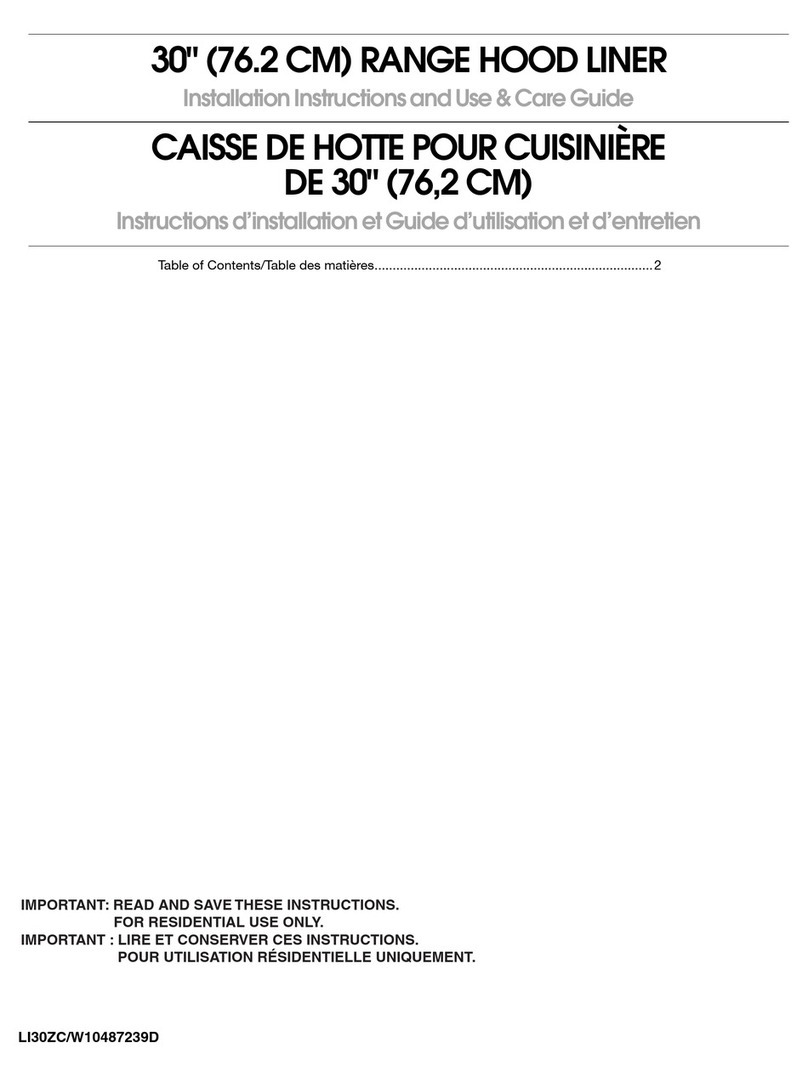
Amana
Amana UXL5430BS Installation instructions and use and care guide

Whirlpool
Whirlpool WVW91336KS user manual
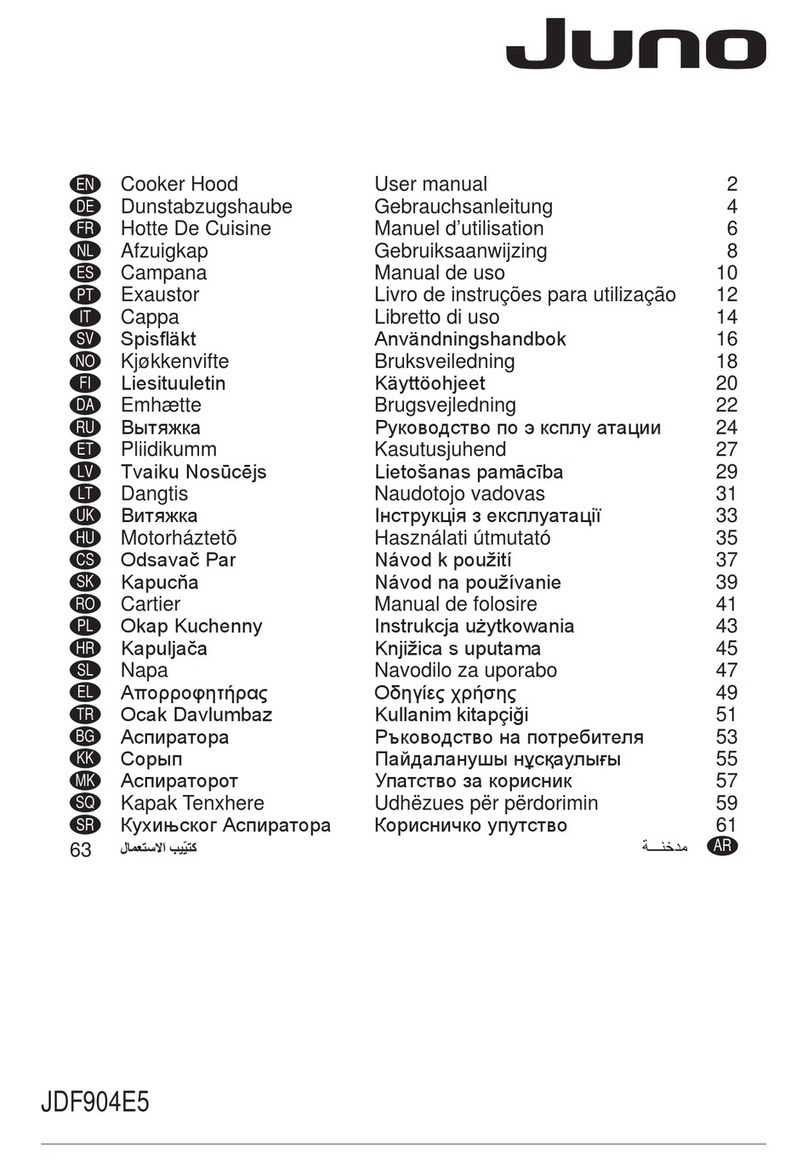
JUNO
JUNO JDF904E5 user manual

KOBE
KOBE IS2436GSF-1 Installation instructions and operation manual
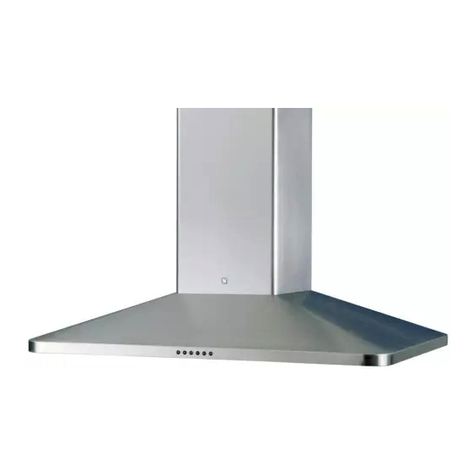
Sirius Range Hoods
Sirius Range Hoods SIU4 installation instructions
